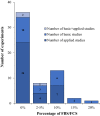Status in molluscan cell line development in last one decade (2010-2020): impediments and way forward
- PMID: 36110153
- PMCID: PMC9374870
- DOI: 10.1007/s10616-022-00539-x
Status in molluscan cell line development in last one decade (2010-2020): impediments and way forward
Abstract
Despite the attempts that have started since the 1960s, not even a single cell line of marine molluscs is available. Considering the vast contribution of marine bivalve aquaculture to the world economy, the prevailing viral threats, and the dismaying lack of advancements in molluscan virology, the requirement of a marine molluscan cell line is indispensable. This synthetic review discusses the obstacles in developing a marine molluscan cell line concerning the choice of species, the selection of tissue and decontamination, and cell culture media, with emphasis given on the current decade 2010-2020. Detailed accounts on the experiments on the virus cultivation in vitro and molluscan cell immortalization, with a brief note on the history and applications of the molluscan cell culture, are elucidated to give a holistic picture of the current status and future trends in molluscan cell line development.
Supplementary information: The online version contains supplementary material available at 10.1007/s10616-022-00539-x.
Keywords: Cell line; Culture medium; Decontamination; Immortalization; Molluscan cell culture; Transfection; Transformation; Virus.
© The Author(s), under exclusive licence to Springer Nature B.V. 2022.
Conflict of interest statement
Competing interestThe authors declare that they have no competing interests.
Figures







References
-
- Alavi MR, Fernández-Robledo JA, Vasta GR. Development of an in vitro assay to examine intracellular survival of Perkinsus marinus trophozoites upon phagocytosis by oyster (Crassostrea virginica and Crassostrea ariakensis) hemocytes. J Parasitol. 2009;95:900–907. doi: 10.1645/GE-1864.1. - DOI - PubMed
-
- Awaji M, Machii A. Fundamental studies on in vivo and in vitro pearl formation—contribution of outer epithelial cells of pearl oyster mantle and pearl sacs. Aqua-BioSci Monogr. 2011;4:1–39. doi: 10.5047/absm.2011.00401.0001. - DOI
Publication types
LinkOut - more resources
Full Text Sources

